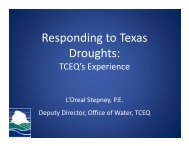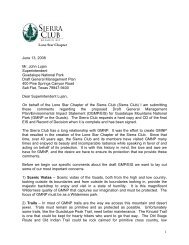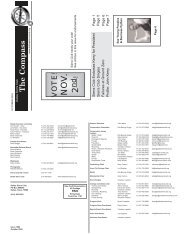Fall 2002 - Lone Star Chapter, Sierra Club
Fall 2002 - Lone Star Chapter, Sierra Club
Fall 2002 - Lone Star Chapter, Sierra Club
Create successful ePaper yourself
Turn your PDF publications into a flip-book with our unique Google optimized e-Paper software.
Texas Parks & Wildlife Releases<br />
Land & Water Conservation Plan<br />
By Brian Sybert, Natural Resources Director, <strong>Lone</strong> <strong>Star</strong> <strong>Chapter</strong><br />
Note: In order to be included in this issue of the <strong>Lone</strong> <strong>Star</strong> <strong>Sierra</strong>n this article had to be<br />
written before the Land & Water Conservation Plan was adopted by the Texas Parks &<br />
Wildlife Commission on August 29. As a result the final recommendations of the plan<br />
were not known when this article was written.<br />
<strong>Lone</strong> <strong>Star</strong> <strong>Sierra</strong>n <strong>Fall</strong> <strong>2002</strong> 13<br />
Your Environment<br />
In June the Texas Parks and<br />
Wildlife Department (TPWD) released<br />
the draft statewide Land & Water<br />
Conservation Plan. The release of<br />
the draft initiated a formal public<br />
comment period on the statewide<br />
conservation plan. Thanks to the<br />
hundreds of citizens who commented<br />
and attended public hearings it is<br />
likely that the final plan adopted by<br />
the Texas Parks and Wildlife Commission,<br />
the governing board for<br />
TPWD, will be stronger that the draft.<br />
Overall the draft plan included<br />
several important recommendations<br />
for how TPWD would address Texas’<br />
rapidly growing conservation and<br />
recreation needs. However, the draft<br />
plan was seriously deficient in<br />
several areas.<br />
State Parkland<br />
In regard to state parkland the<br />
draft plan recommended that TPWD<br />
acquire four to six 5,000-acre or<br />
more state parks or combination<br />
state parks and wildlife management<br />
areas near major urban centers<br />
over the next ten years. While<br />
this recommendation is a good<br />
starting point it is not adequate for<br />
meeting our state’s growing need for<br />
parkland and habitat conservation.<br />
In comments submitted to TPWD<br />
the <strong>Lone</strong> <strong>Star</strong> <strong>Chapter</strong> of the <strong>Sierra</strong><br />
<strong>Club</strong> recommended that TPWD adopt<br />
the goal of providing 55 acres of<br />
parkland per 1000 people. At an<br />
absolute minimum, the <strong>Chapter</strong><br />
suggested that TPWD adopt the goal<br />
of acquiring 15 new state parks near<br />
the major urban centers of the state.<br />
These goals are based upon population<br />
growth and would allow TPWD to<br />
take action during the next 10 years<br />
to meet the state’s growing conservation<br />
and recreation needs while also<br />
avoiding placing the state in a<br />
position of facing unrealistically<br />
daunting challenges at the end of the<br />
10-year period.<br />
Local Parkland<br />
In regard to local parkland the<br />
draft plan recommended that TPWD<br />
continue to support local parkland<br />
needs through competitive grants to<br />
local governments. While this is an<br />
important goal it alone is not sufficient<br />
for meeting the growing need<br />
for more local parks.<br />
The <strong>Lone</strong> <strong>Star</strong> <strong>Chapter</strong>’s comments<br />
recommended TPWD should<br />
adopt the goal of working with local<br />
governments to provide 25 acres of<br />
local parkland per 1000 people<br />
through federal and state matchingfunds.<br />
This goal is also based on<br />
population growth and will allow<br />
TPWD and local governments to<br />
better meet local parkland needs.<br />
Wildlife Habitat<br />
To address conservation of wildlife<br />
habitat the draft plan recommended<br />
that TPWD increase private lands<br />
under wildlife management plans to<br />
14 million acres over the next ten<br />
years. While wildlife management<br />
plans are an important tool for<br />
protecting habitat on private lands<br />
they do not permanently protect<br />
lands from development and fragmentation.<br />
The <strong>Lone</strong> <strong>Star</strong> <strong>Chapter</strong>’s comments<br />
recommended that to effec-<br />
Continued next page<br />
Photo Courtesy of Texas Department of Transportation







